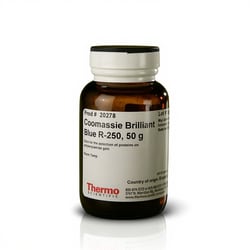Learn More
Thermo Scientific™ Pierce™ Coomassie Brilliant Blue Dyes
Shop All Thermo Scientific ProductsDescription
Thermo Scientific Pierce Coomassie Brilliant Blue dyes are composed of one of the most common forms of coomassie dye, which is a key component of various colorimetric protein gel stains. Coomassie R-250 and G-250 dyes are two chemical forms of a disulfonated triphenylmethane compound that is commonly used as the basis of stains for detection of proteins in gel electrophoresis and Bradford-type assay reagents for protein quantitation. The R-250 (red-tinted) form lacks two methyl groups that are present in the G-250 (green-tinted) form, which is also called colloidal coomassie dye.
Typically, coomassie gel stains and protein assay reagents are formulated as very acidic solutions in 25 to 50% methanol. In acidic conditions, the dye binds to proteins primarily through basic amino acids (primarily arginine, lysine, and histidine), and the number of coomassie dye ligands bound to each protein molecule is approximately proportional to the number of positive charges found on the protein. Protein binding causes the dye to change from reddish-brown to bright blue (absorption maximum equals 595 nm).
Features include:
• Easy detection—develops intensely colored complexes with proteins
• High sensitivity—can determine as little as 0.5 μg/cm2 of protein present in a gel matrix
• Reversible staining—anion of Coomassie Brilliant Blue dye formed in the acidic staining medium combines with the protonated amino groups of proteins by electrostatic interaction; resulting complex is reversible under proper conditions
• Differentiation between bound and unbound dye—when dissolved in 0.01 M citrate buffer at pH 3.0, has an absorption maximum at 555 nm; protein-dye complex is characterized by a peak slightly broader than that of free dye with a maximum at 549 nm

Specifications
Specifications
| Content And Storage | Store at room temperature. |
| Detection Location | In-Gel Detection, In-Solution Detection, In-Blot Detection |
| Detection Method | Colorimetric |
| Label or Dye | Coomassie |
| Product Type | Protein Gel Stain |
| Stain Type | Brilliant Blue R-250 Dye |
| Product Line | Pierce |
| Quantity | 50 g |
| Target Molecule | Protein |
Your input is important to us. Please complete this form to provide feedback related to the content on this product.
